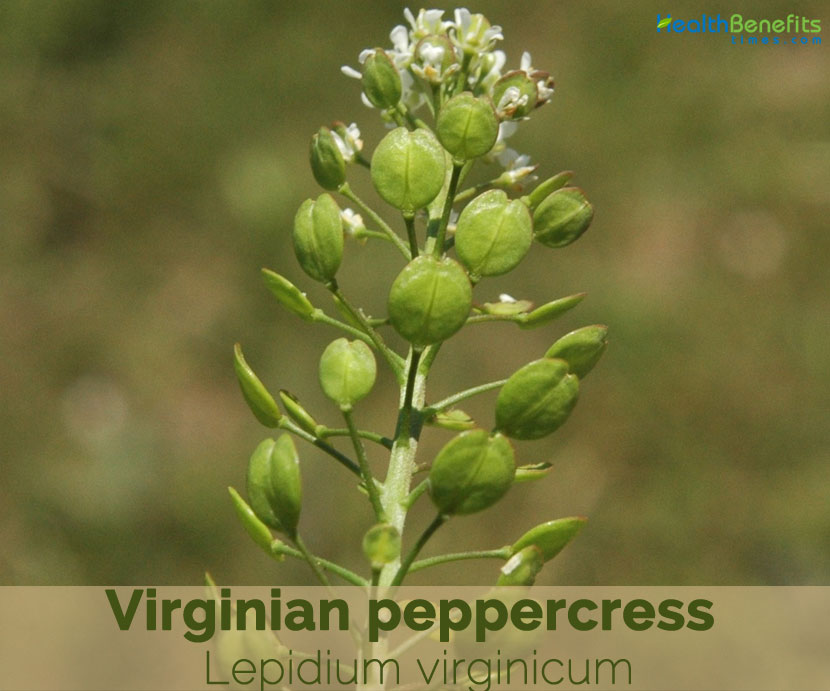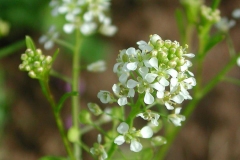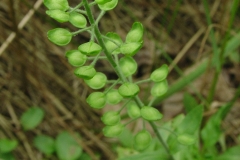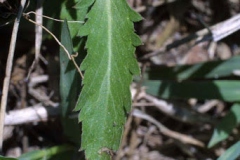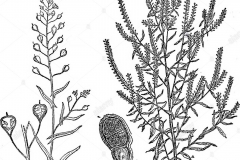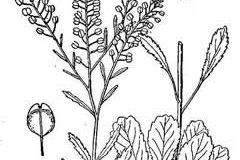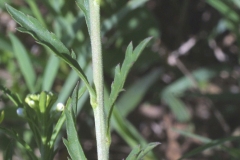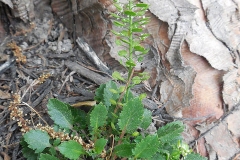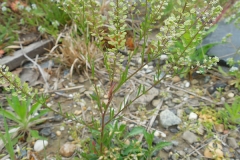| Virginian peppercress Quick Facts | |
|---|---|
| Name: | Virginian peppercress |
| Scientific Name: | Lepidium virginicum |
| Origin | North America, including most of the United States and Mexico and southern regions of Canada |
| Shapes | Flat pod, round in outline, usually slightly wider than long, widest near the middle, up to about 1/6 inch (4mm) long |
| Taste | Pungent, peppery taste |
| Health benefits | Good for scurvy, diarrhea, dysentery, for renal and liver diseases, abdominal pains, worm infections, rheumatic pain, coughs and croups, diabetes. |
| Name | Virginian peppercress |
|---|---|
| Scientific Name | Lepidium virginicum |
| Native | North America, including most of the United States and Mexico and southern regions of Canada, as well as most of Central America. It grows all over Europe, parts of Asia, South America and Australia |
| Common Names | Least pepperwort, Peppergrass, Poor-man’s-pepper, Virginia cress, Virginia pepper cress, Virginia pepperweed, Common Peppergrass, Poor-man’s Pepper-grass, Virginian peppercress, Poor-man’s pepperweed, Poorman pepperweed, Poorman’s pepper, Poorman’s pepperwort, Poor man’s Pepper, Virginia Peppergrass, Wild Pepper-grass, Poorman’s-Pepperwort, Poor-man’s peppergrass, Poor-man’s pepper |
| Name in Other Languages | Albanian: Djegës Australia: Virginia pepper cress Bahamas: Wild pepper-grass Brazil: Mastruco, mastruz, menstruz Canada: Poor-man’s pepper-grass Catalan: Morritort, Morritort de virgínia China: Bei mei du xing cai (北美独行菜) Cook Islands: Naunau Croatian: Virginska grbica Cuba: Mastuerzo, sabelección, tostón Czech: Řeřicha virginská, Žerucha virgínska Danish: Smalbladet plydsmos, Stor andemadsbregne, Virginsk karse Dutch: Amerikaanse kruidkers, Virginische kruidkers Dominican Republic: Mastuerzo English: Least pepperwort, pepper grass, poorman’s pepperwort, Virginia cress, Virginia pepper grass, Virginia pepperweed, wild peppercress, Virginia pepper cress, Virginian peppercress, Poor-man’s-pepper, Poorman pepperweed, Poorman’s pepperwort, Poor-man’s peppergrass, Poor-man’s pepper, Intermediate pepperweed, Menzies’ pepperweed, Hairy pepperwe Estonian: Virgiinia kress Finnish: Virginiankrassi French: Cresson a savane, cresson sauvage, lépidie de Virginie, passerage de Virginie, cresson-savane Germany: Virginische kresse, Virginische Kresse, Texas-Kresse, amerikanische Kresse Haiti: Cresson alénois, cresson danois, cresson de savane, cresson savane Hungarian: Virginiai zsázsa, amerikai zsázsa Icelandic: Hæruburst, virginíuperla Ireland: Least pepperwort Italian: Lepidio della Virginia Jamaica: Wild peppergrass Japan: Mamegunbainazuna, マメグンバイナズナ, Koubenazuna (コウベナズナ), mame-gumbai-nazuna Latvian: Virdžīnijas cietķērsa Lithuanian: Virgininė pipirnė Lower Sorbian: Wirgińska krjasa Maori (Cook Islands): Naunau Mexico: Comida de pajarito, isohuanquil, lentejilla, lentejilla de campo, mexix-quilitl, mixixi, panalillo, put-kan, quelites, rochihuari, xixinda Netherlands: Virginische kruidkers Niue: Momili Norwegian: Virginiakarse Peru: Cresón, mancuerno Polish: Passerage de Virginie, Pieprzyca wirgińska Portuguese: Mastruco, mastruz, mentruz, Mentrusto Puerto Rico: Cresón, lentejilla, mastuerzo Russian: Klopovnik virginskiy (клоповник виргинский) Slovak: Zerucha virginská Slovene: Virginijska draguša Spanish: Culantrillo, lentejilla, mancuerno, mastuerzo, mastuerzo Silvestre, Perejil de la Tierra, cresón, escobilla, sabelección Sweden: Virginiakrassing, Kapmossa, Kvastmossa, Mossbräken, Virginiakrassing, Virginiankrassi, grenkrassing Tongan: Momili Turkish: Eltere UK: Least pepperwort Upper Sorbian: Wirginska žerchej USA: Bird-pepper, common peppergrass, peppergrass, poor-man’s pepper, tongue-grass, Virginia cress, Virginia pepper-weed Venezuela: Escobilla Welsh: Pupurlys bach |
| Plant Growth Habit | Herbaceous annual or biennial plant |
| Growing Climates | Along railways, in arable fields, prairies, pastures, roadsides, lawns, gardens, waste places, chaparral, coastal sage scrub, disturbed areas, woodland edges, vacant lots, gravelly junkyards, glades, tops of bluffs, rocky openings of dry upland forests |
| Soil | Soil can contain loam, gravel, or clay, and range from sterile to highly fertile |
| Plant Size | Between 10 and 50 centimeters tall |
| Root | Root system consists of a slender, branching taproot |
| Stem | Stems are green or slightly reddish pink, and are covered with fine white hairs that are very short. Stem’s upper part branching |
| Leaf | Cauline leaves are up to 3½” long and ¾” across, and usually oblanceolate or obovate. They are sessile at the base (appearing to have winged petioles), and the larger leaves have a few coarse teeth toward their tips |
| Flowering season | May to October |
| Flower | Each flower has 4 white petals and 4 green sepals, and is less than 1/8 inches (3 mm.) across. A typical raceme will have a few flowers in bloom at the top. The flowers have no noticeable scent |
| Fruit Shape & Size | Seedpods about 1/8 inches (3 mm.) in length at varying stages of maturity. Each flattened seedpod has a round oval shape with a small notch at the tip |
| Seed | Reddish brown, slightly compressed or flattened, ovate-ovoid, narrowly winged distally, about 1.5-2 x 0.8 mm across, smooth minutely reticulate, nicely mucilaginous when soaked, cotyledons accumbent rarely incumbent |
| Propagation | By seed |
| Taste | Pungent, peppery taste |
| Plant Parts Used | Leaves, root |
| Other Facts |
|
Plant Description
Virginian peppercress is a herbaceous annual or biennial plant that normally grows between 10 and 50 centimeters tall. The plant is found growing along railways, in arable fields, prairies, pastures, roadsides, lawns, gardens, waste places, chaparral, coastal sage scrub, disturbed areas, woodland edges, vacant lots, gravelly junkyards, glades, tops of bluffs and rocky openings of dry upland forests. Soil should be loam, gravel, or clay, and range from sterile to highly fertile. Root system consists of a slender, branching taproot. Stems are green or slightly reddish pink, and are covered with fine white hairs that are very short. Stem’s upper part is branching.
Leaves
Leaves are in a basal rosette as well as alternate all along the stem. Basal leaves are long stalked, spatula shaped to pinnately lobed and wilt away early. It is about 4-9 cm long and 0.7-1.5 cm across, glabrous, midrib impressed above and prominent beneath, petiole about 0.5-3.5 cm long. Lower stem leaves are irregularly toothed or lobed, 10-50 mm long, up to 3-9 mm across, widest above the middle, tapering to a stalk at the base. Leaves usually become more linear, less toothy, and stalkless as they ascend the stem. Surfaces are minutely hairy. Stem and leaf hairs are cylindric and mostly curved.
Flower
Elongating clusters of stalked flowers appears at the top of the plant and at the tips of branching stems arising from the upper leaf axils, with a densely packed, rounded cluster of open flowers at the tip and fruit forming below. Flowers are tiny, less than 1/8 inch across, with 4 white, paddle-shaped petals alternating with 4 oblong-elliptic sepals that are light green with thin, whitish edging and have a few hairs on the outer surface. Petals are about twice as long as the sepals but occasionally petals are absent altogether. In the center are 2 yellow-tipped stamens and a stubby, white style at the tip of a green ovary. Flower stalks are minutely hairy, the hairs cylindric and mostly curved. Flowering normally takes place between May to October.
Fruit
Fertile flowers are followed by a flat pod, round in outline, usually slightly wider than long, widest near the middle, up to about 1/6 inch (4mm) long with a small notch at the tip. It dries to a papery brown shell and splits down the middle when mature.
Each side of the pod contains a single seed. Inside the seed, the pair of seed leaves (cotyledons) is parallel to each other but perpendicular to the embryo, as viewed in cross-section.
Traditional uses and benefits of Virginian peppercress
- It is used to treat vitamin C deficiency, pains, diabetes, blisters, colic in babies, as a decongestant, anti-asthmatic, antitussive, and cardio-tonic and as a diuretic.
- North American Indians use it to treat poison ivy rash and scurvy.
- It is also used in Mexico for the treatment of diarrhea, dysentery, for renal and liver diseases, abdominal pains and worm infections.
- Leaves of wild pepper-grass are nutritious and generally detoxifying, they have been used to treat vitamin C deficiency and diabetes, and to expel intestinal worms.
- The herb is also diuretic and of benefit in easing rheumatic pain.
- North American Indians used the bruised fresh plant, or a tea made from the leaves to treat poison ivy rash and scurvy.
- Poultice of the leaves was applied to the chest in the treatment of croup.
- Seed is anti-asthmatic, antitussive, cardio-tonic and diuretic.
- It is used in the treatment of coughs and asthma with excessive phlegm, edema, oliguria and liquid accumulation in the thoraco-abdominal cavity.
- Poultice of the bruised roots has been used to draw out blisters.
- Root is used to treat excess catarrh within the respiratory tract.
- Seeds were used to treat coughs and croups.
- The crushed roots were used to draw wounds and blisters.
Culinary uses
- Almost all parts of the plants are edible.
- The leaves are eaten raw or cooked and are a source of vitamin C.
- The seedpods are eaten raw, used as a condiment or as a pepper substitute.
- Young leaves can be consumed raw or cooked.
- The leaves are a rich source of vitamin C and have a hot cress-like flavor.
- Chopped finely and added to salads, used as a garnish or cooked as greens.
- Unripe seedpods have a pleasantly pungent flavor and can be eaten raw or used as a condiment in soups and stews.
- The seed is a pepper substitute.
- The young leaves can be used as a potherb, sautéed or used raw, such as in salads.
- The young seedpods can be used as a substitute for black pepper.
- The flowers can be tossed into a salad and the roots.
- The entire plant can be put into a food processor along with turmeric, vinegar, miso, garlic and salt to make wild mustard.
- Collect roots, wash them, crush them and add vinegar and salt you have a horseradish substitute.
Prevention and Control
Due to the variable regulations around (de)registration of pesticides, your national list of registered pesticides or relevant authority should be consulted to determine which products are legally allowed for use in your country when considering chemical control. Pesticides should always be used in a lawful manner, consistent with the product’s label.
Prevention
Information about L. virginicum and its effects is available for the public over the internet. Some examples are: information for cattle breeders in Mexico; an illustrated database of the alien plants in South Korea. There is also a species profile in the Global Invasive Species Databas.
Control
L. virginicum is resistant to paraquat. The following herbicides and their effectiveness are reported by Richardson and Zandstra (2009): flumioxazin (96%), flumioxazin with pendimethalin (88%), sulfentrazone with pendimethalin (86%), isoxaben with pendimethalin (68%), oxyluorfen with pendimethalin (68%) and simazine with pendimethalin (53%).
References:
https://www.cabi.org/isc/datasheet/30303
http://www.theplantlist.org/tpl/record/kew-2341702
https://www.itis.gov/servlet/SingleRpt/SingleRpt?search_topic=TSN&search_value=22955#null
http://www.hear.org/pier/species/lepidium_virginicum.htm
https://npgsweb.ars-grin.gov/gringlobal/taxon/taxonomydetail?id=21770
https://pfaf.org/user/Plant.aspx?LatinName=Lepidium+virginicum
http://www.floracatalana.net/lepidium-virginicum-l-subsp-virginicum
https://plants.usda.gov/core/profile?symbol=LEVI3
https://en.wikipedia.org/wiki/Lepidium_virginicum
http://www.theplantlist.org/tpl/record/kew-2341702
https://indiabiodiversity.org/species/show/230207
https://gobotany.nativeplanttrust.org/species/lepidium/virginicum/
http://tropical.theferns.info/viewtropical.php?id=Lepidium+virginicum
https://gd.eppo.int/taxon/LEPVI
https://www.illinoiswildflowers.info/weeds/plants/cm_peppergrass.htm
https://www.minnesotawildflowers.info/flower/virginia-peppergrass


